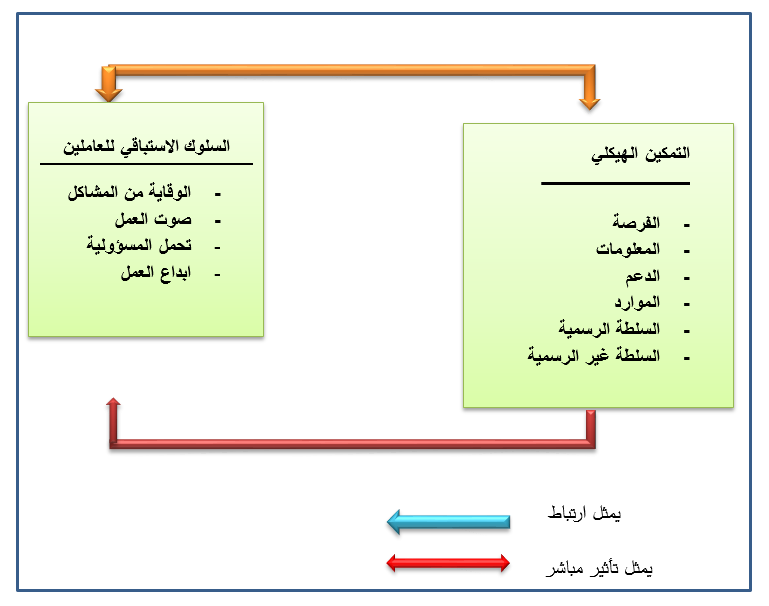The role of structural empowerment in promoting proactive behavior
بحث تحليأتي لآراء عينة من منسوبي مديرية بلدية كربلاء المقدسة
Keywords:
structural empowerment, proactive behavior, The role of structural empowerment in promoting proactive behaviorAbstract
This research seeks to determine the effect of structural empowerment on proactive behavior. Through its dimensions (prevention of problems, voice of work, responsibility and creativity of work), the research problem started from the reality of the Karbala Municipality Directorate, which did not achieve the required level in providing its services to its beneficiaries. Although its administration is trying hard to enhance the proactive behavior of its personnel in order to reach the highest levels between local and regional organizations, a hypothetical scheme has been built that reflects the researcher’s perceptions of the nature of the relationship between the variables and how the situation of the Holy Karbala municipality can change, according to two main hypotheses, the first relating to The content of the correlation relationship (there is a statistically significant correlation between structural empowerment and proactive behavior), while the second hypothesis concerns the level of influence between the two variables with its content (there is a significant effect relationship between structural empowerment and proactive behavior in its dimensions at the level of the Holy Karbala Municipality Directorate).The research was conducted in the Directorate of Karbala Municipality (the center), as the necessary information for the field side was obtained through the questionnaire prepared for this purpose. The practical side, including (Cronbach’s alpha coefficient, arithmetic mean, standard deviation, Pearson correlation coefficient, simple regression analysis, (F) test, coefficient of determination (R2), and marginal slope coefficient (β). Through programs Statistics (SPSS.V.25).
The research reached several results, including the presence of a statistically significant effect between structural empowerment and proactive behavior, and based on the results, the researcher presented a set of recommendations, the most prominent of which is that the Karbala Municipality Directorate seeks to increase interest in the side of structural empowerment of its employees for the purpose of achieving its planned goals, and seeking to increase interest In addition to the proactive behavior of its employees in order to arouse their talents and intellectual abilities to enable them to develop appropriate solutions to work problems that may hinder the completion of their tasks.
References
اولا- العربية:
لينا عبد الحميد أمين عبد الرحيم , 2009 , أثر النمط القيادي لمدراء المكتب الإقليمي بغزة (الأونروا) على تهيئة البيئة الإبداعية للعاملين, قدمت هذه البحث استكمالا لمتطلبات الحصول على درجة الماجستير في إدارة الأعمال, الجامعة الإسلامية – غزة عمادة الدراسات العليا كلية التجارة قسم إدارة الأعمال.).
عامر علي حسين العطري وكمال كاظم الحسيني ,(2018) , (دور ثقافة ادارة الخطأ في تعزيز سلوك العمل الأستباقي عن طريق الدور الوسيط للتمكين النفسي ),دراسة تحليلية متعددة المستويات ,جامعة المثنى ,كلية الادارة والاقتصاد ,قسم ادارة الاعمال .مجلة الغزي للعلوم الاقتصاد والادارة ,مجلد الخامس عشر ,العدد (4) سنة ( 2018).
ثانيا- الاجنبية:
Barney, J.B. (2007). Gaining and sustaining competitive advantage. 3rd Edition, New Jersey: Pearson Publishers.
Belschak, F. D., & Den Hartog, D. N. (2010). Pro‐self, prosocial, and pro‐organizational foci of proactive behaviour: Differential antecedents and consequences. Journal of occupational and organizational psychology, 83(2), 475-498.
Bindl, U. K., & Parker, S. K. (2011). Proactive work behavior: Forward-thinking and change-oriented action in organizations. In APA handbook of industrial and organizational psychology, Vol 2: Selecting and developing members for the organization. (pp. 567-598). American Psychological Association.
Cohen, J., and Cohen, P. (Applied Multiple Regression/ Correlation Analysis for the Behavioral Sciences) 2nd Ed. New York: Lawrence Erlbaum Associates 1983.
Cowden, T. L., & Cummings, G. G. (2012). Nursing theory and concept development: a theoretical model of clinical nurses’ intentions to stay in their current positions. Journal of advanced nursing, 68(7), 1646-1657.
Crant, J. M. (2000). Proactive behavior in organizations. Journal of management, 26(3), 435-462.
De Vries, G., Jehn, K. A., & Terwel, B. W. (2012). When employees stop talking, and start fighting:- The detrimental , effects of pseudo voice in organizations., Journal of Business Ethics, ,.105(2), 221-230.
Dewberry, C. (Statistical Methods for Organizational Research : Theory and practice) First published, Published in the Taylor & Franci, 2004.
Ellis, A. M. (2012). The role of psychological resources in the relationship between work stressors and proactive behavior. Portland State University.
Fragkos, K. C., Makrykosta, P., & Frangos, C. C. (2020). Structural empowerment is a strong predictor of organizational commitment in nurses: A systematic review and meta‐analysis. Journal of Advanced Nursing, 76(4), 939-962.
Frese, M., & Fay, D. (2001). 4. Personal initiative: An active performance concept for work in the 21st century. Research in organizational behavior, 23, 133-187.
GILBERT, S., H. K. S. LASCHINGER and M. LEITER, 2010. The mediating effect of burnout on the relationship between structural empowerment and organizational citizenship behaviours. Journal of Nursing Management, Vol. 18, p. 339-348.
Goepel, M., Hölzle, K., & zu Knyphausen‐Aufseß, D. (2012). Individuals’ innovation response behaviour: A framework of antecedents and opportunities for future research. Creativity and Innovation Management, 21(4), 412-426.
Hock, B. A. (2020). Creating a Structural Empowerment Culture: A Professional Development Module for the Novice Nurse Leader (Doctoral dissertation, University of Nevada, Las Vegas.
Johnson, J.V. and Hall, E.M. (1988), "Job strain, work place social support, and cardiovascular disease: s cross-sectional study of a random sample of the Swedish working population", American Journal of Public Health, Vol. 78 No. 10, pp. 1336-1342.
Kanter, Rosabeth Moss. 1977. Men and Women of the Corporation, 2nd ed. New York: BasicBooks. Kanter, Rosabeth Moss. 1979. Power failure in management circuits. Harvard Business Review 57: 65.
Knight-Turvey, N. (2006). Influencing employee innovation through structural empowerment initiatives: The need to feel empowered. Entrepreneurship Theory and practice, 43, 313-324.
Laschinger, H. K. S. (2008). Effect of empowerment on professional practice environments, work satisfaction, and patient care quality: Further testing the nursing worklife model. Journal of nursing care quality, 23(4), 322-330.
Laschinger, H. K. S., Finegan, J. E., Shamian, J., & Wilk, P. (2004). A longitudinal analysis of the impact of workplace empowerment on work satisfaction. Journal of Organizational Behavior: The International Journal of Industrial, Occupational and Organizational Psychology and Behavior, 25(4), 527-545.
Laschinger, H. K. S., Leiter, M. P., Day, A., Gilin-Oore, D., & Mackinnon, S. P. (2012). Building empowering work environments that foster civility and organizational trust: Testing an intervention. Nursing research, 61(5), 316-325.
Martin, T. A. (2010). Formal and informal power, access to work empowerment structures and intent to stay.
Marx, Karl. 1964. Economic ,.and Philosophic Manuscripts of 1844,. New York:- Inter- national Publishers.,
Moon, H., Van Dyne, L., & Wrobel, K. (2005). The circumplex model and the future of organizational citizenship behavior research. Handbook of organizational citizenship behavior, 3-23.
Morrison, E. W. (2014). Employee voice and silence. Annual Review of Organizational Psychology and Organizational Behavior, 1(1), 173-197.
Morrison, E. W., & Phelps, C. C. (1999). Taking charge at work: Extrarole efforts to initiate workplace change. Academy of management Journal, 42(4), 403-419.
Mota, A. (2015). Structural Empowerment: A Qualitative Inquiry Into the Work Life of the Oncology Nurse.
O'Brien, J. L. (2010). Structural empowerment, psychological empowerment and burnout in registered staff nurses working in outpatient dialysis centers (Doctoral dissertation, Rutgers University-Graduate School-Newark.
Parker, S. K., & Collins, C. G. (2010). Taking stock: Integrating and differentiating multiple proactive behaviors. Journal of management, 36(3), 633-662.
Parker, S. K., Williams, H. M., & Turner, N. (2006). Modeling the antecedents of proactive behavior at work. Journal of applied psychology, 91(3), 636.
Searle, T. P. (2011). A multilevel examination of proactive work behaviors: Contextual and individual differences as antecedents. The University of Nebraska-Lincoln.
Seibert, Scott E., Gang Wang, and Stephen H. Courtright. "Antecedents and consequences of psychological and team empowerment in organizations: a meta-analytic review." Journal of applied psychology 96.5 (2011): 981.
Smith, T., Capitulo, K. L., QUINN GRIFFIN, M. T., & Fitzpatrick, J. J. (2012). Structural empowerment and anticipated turnover among behavioural health nurses. Journal of Nursing Management, 20(5), 679-684.
Spreitzer, G. M. (2008). Taking stock: A review of more than twenty years of research on empowerment at work. Handbook of organizational behavior, 1, 54-72.
Thomas, J. P., Whitman, D. S., & Viswesvaran, C. (2010). Employee proactivity in organizations: A comparative meta‐analysis of emergent proactive constructs. Journal of occupational and organizational psychology, 83(2), 275-300.
van den Berg, J., Alblas, A., Blanc, P. L., & Romme, A. G. L. (2021). How structural empowerment boosts organizational resilience: A case study in the Dutch home care industry. Organization Studies, 01708406211030659.
Van Dyne, L., & Le Pine, J. A. (1998). Helping .,and voice extra-role behaviors:- Evidence of construct,. and predictive validity,. Academy of Management journal, .41(1), 108-119,.
Van Dyne, L., Ang,. S., & Botero, I. C. (2003)., Conceptualizing Employee Silence and Employee Voice TO as Multidimensional Constructs,. Journal of Management Studies,.. 40(6), pp. 1359-1392.,
Wu, C. H., & Parker, S. K. (2017). The role of leader support in facilitating proactive work behavior: A perspective from attachment theory. Journal of Management, 43(4), 1025-1049.
Yoon, J. (2001). The role of structure and motivation for workplace empowerment: The case of Korean employees. Social psychology quarterly, 195-206.
Yuki, Gary A. & Becker, Wendy S., (2006), Effective Empowerment in Organization, Organization Management Journal, Vol. 3, No. 3.
Zenger, T. R., Lazzarini, S. G., & Poppo, L. (2001). Informal and formal organization in new institutional economics. Unpublished manuscript.

Downloads
Published
How to Cite
Issue
Section
License
Copyright (c) 2024 College of Administer and Economics - Kerbela University

This work is licensed under a Creative Commons Attribution-NonCommercial-NoDerivatives 4.0 International License.
Authors retain the copyright of their papers without restrictions.









